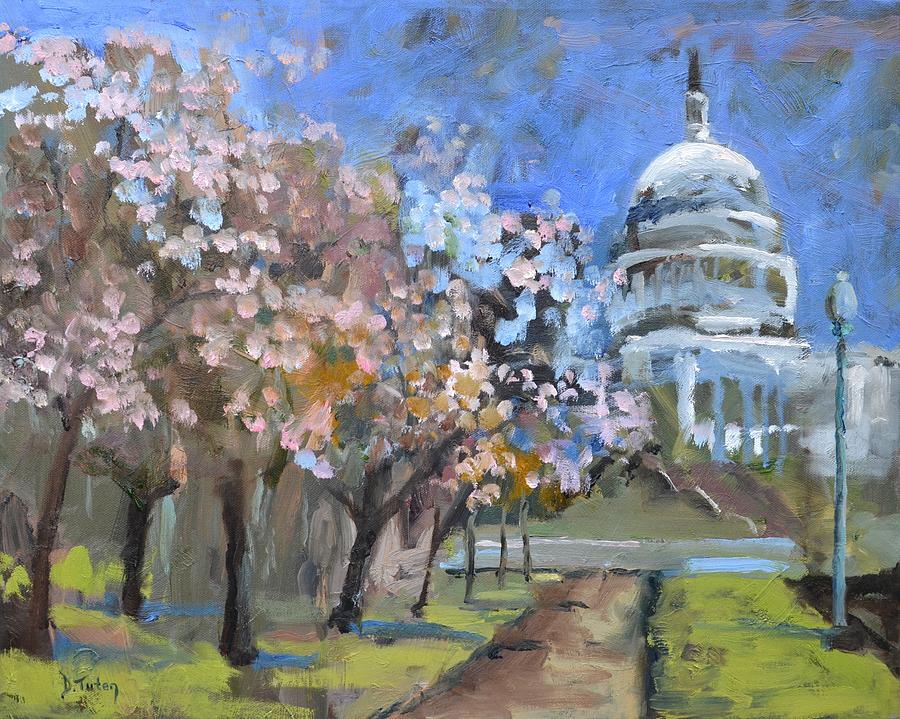 (Illustration: ‘Cherry Tree Blossoms in Washington DC,’ by Donna Tuten, and found here).
(Illustration: ‘Cherry Tree Blossoms in Washington DC,’ by Donna Tuten, and found here).
In the onslaught of frightful items on the agenda of the nowadays, from COVID to racism to economic woes, the huge, massive elephant in the room (no, not the GOP’s repugnant replica) can easily be overlooked/overshadowed by these pressing issues, and that’s climate change.
Just because it’s seemingly backburner doesn’t mean it’s not happening right now.
And obvious.
Beyond the reports of drought, weird-ass weather and high temperatures (I even whined about the un-Spring-like hotness last weekend), one glaringly-open example of global warming is the annual blooming of the cherry blossoms in DC, which this year in a period of unusual heat, has caused the National Mall’s 3,800 cherry trees to bloom days ahead of schedule — from the Guardian this morning:
“Empirical data shows the peak bloom date for the cherry trees is occurring earlier than it did in the past,” said Mike Litterst, a spokesman for the National Park Service.
Washington’s cherry trees now reach peak bloom about six days sooner than they did 100 years ago. At the same time, weather station measurements in the US capital show the temperature has increased by 1.6C (2.88F).
“Since heat breaks dormancy in flowering trees, earlier cherry blooming is consistent with heating caused by climate change, although research has not yet examined all of the potential factors that could have caused the earlier blooming,” Litterst said.
The trees at the Tidal Basin reached their flowery peak on 28 March, according to the park service, which defines “peak bloom” as the day when 70% of the Yoshino cherry blossoms open. On 4 March, the park service predicted peak bloom would fall between 2 April and 5 April.
“The Yoshino cherry trees have reached peak bloom after temperatures well above average for much of the last week sped us through the final stages of the blossom cycle,” the agency wrote on Instagram. It added that the warm weather propelled the cherry blossom buds through the final stages of their six-stage cycle, advancing them from peduncle elongation – stage 4 – to peak bloom in just four days.
…
Washington’s bloom came just two days after the cherry blossoms in Kyoto reached peak bloom on 26 March, the earliest in nearly 70-years of formal record keeping – and possibly ever.“We can say it’s most likely because of the impact of the global warming,” Shunji Anbe, an official at the observations division at the Japan Meteorological Agency, told the Associated Press.
And of Japan, the original cherry blossom land:
?Cherry blossoms in Tokyo reached full bloom Monday, making it the second earliest on record. "Full bloom" is when 80% of blossoms on the observation tree in Yasukuni Shrine are open? pic.twitter.com/H6G6lA0gLk
— Sayaka Mori (@sayakasofiamori) March 22, 2021
The Japanese bloom the earliest in more than a millennium — via The Washington Post last Monday:
Amid an exceptionally warm March in Japan, the cherry blossoms in Kyoto peaked Friday, the earliest in more than 1,200 years of records. The record bloom fits into a long-term pattern toward earlier spring flowering, a compelling indicator of climate change, experts say.
The March 26, 2021, peak bloom date surpassed the previous record holder of March 27, 1409, nearly a century before Christopher Columbus sailed to America. The long-term record dates back to A.D. 812, about 12 years after Charlemagne was crowned Holy Roman Emperor.
“The Kyoto Cherry Blossom record is incredibly valuable for climate change research because of its length and the strong sensitivity of flowering to springtime temperatures (warmer springs = earlier flowering, typically),” Benjamin Cook, a research scientist at Columbia University who specializes in reconstructing climate data from the past, said in an email.
…
“Evidence, like the timing of cherry blossoms, is one of the historical ‘proxy’ measurements that scientists look at to reconstruct past climate,” said Michael Mann, a professor and climate scientist at Pennsylvania State University, who has published numerous studies on temperature changes in recent millennia.
“In this case, that ‘proxy’ is telling us something that quantitative, rigorous long-term climate reconstructions have already told us — that the human-caused warming of the planet we’re witnessing today is unprecedented going back millennia.”
Blooms busting-out is a forerunner to a nasty time ahead if nothing is done.
And in the fictional climate landscape, last night I saw “The Day After Tomorrow” (now on Amazon Prime) for the first time in years, and although it’s near-ludicrous, it does have some awesome special effects, an American asshole vice president who resembles Dick Cheney, and blessed with Ian Holm, Sela Ward, Emmy Rossum, and a way-baby-looking Jake Gyllenhaal — dumb, but with an ironic scariness:
Too cold…